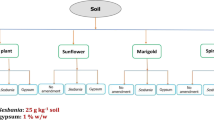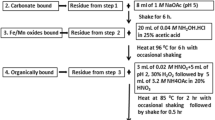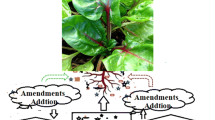Abstract
Soil pollution due to heavy metals is widespread; on the world scale, it involves about 235 million hectares. The objectives of this research were to establish the uptake efficiency of nickel by some agricultural crops. In addition, we wanted to establish also in which part of plants the metal is stored for an eventual use of biomass or for recycling the metal. The experiments included seven herbaceous crops such as: barley (Hordeum vulgaris), cabbage (Brassica juncea), spinach (Spinacea oleracea), sorghum (Sorgum vulgare), bean (Phaseolus vulgaris), tomato (Solanum lycopersicum), and ricinus (Ricinus communis). We used three levels of treatment (150, 300, and 600 ppm) and one control. At the end of the biological cycle of the crops, the different parts of plants, i.e., roots, stems, leaves, fruits, or seeds, were separately collected, oven dried, weighed, milled, and separately analysed. The leaves and stems of spinach showed a very good nickel storage capacity. The ricinus too proved to be a very good nickel storer. The ability of spinach and ricinus to store nickel was observed also in the leaves of cabbage, even if with a lower storage capacity. The bean, barley, and tomato, in decreasing order of uptake and storage capacity, showed a high concentration of nickel in leaves and stems, whereas the sorghum evidenced a lesser capacity to uptake and store nickel in leaves and stems. The bean was the most efficient in storing nickel in fruits or grains. Tomato, sorghum, and barley have shown a storage capacity notably less than bean. The bean appeared to be the most efficient in accumulating nickel in the roots, followed in decreasing order by sorghum, ricinus, and tomato. With regard to the removal of nickel, spinach was the most efficient as it contains the highest level of this metal per gram of dry matter. The ricinus, cabbage, bean, sorghum, barley, and tomato evidenced a progressively decreasing efficiency in the removal of nickel.
Similar content being viewed by others
Literature Cited
Adriano D. C. 1986. Trace elements in the terrestrial environment. Springer-Verlag, New York
Adriano, D. C., A. Chlopecka, D. I. Kaplan, and H. Clijsters. 1997. Soil contamination and remediation: philosophy, science and technology. 3rd International Conference on the biogeochemistry of trace elements. Paris, May 15–19, 1995. INRA, Paris 1997, p 465–499
Alloway B. J. 1990. Heavy metal in soils. Blackie Glasgow and London. John Wiley & Sons, Inc. New York, p. 339
Alloway B. J. 1995. Heavy metal in soils. Blackie Academy & Professional, UK
Alloway B. J. 1997. The mobilisation of trace elements in soils. In: Contaminated soils; INRA, Paris, 1997; Les colloques n. 85
Cannon H. L., G. C. Connally, J. B. Epstein, J. G. Parker, I. Thornton, G. Wixon 1978. Rocks: geological sources of most trace elements. Report of the Workshop at South Seas Plantation, Captiva Islands, FL, U.S. Geoch Environ 3:17–31
Kabata R., A. Pendias, H. Pendias 1992. Trace elemets in soils and plants, 2nd ed. CRS Press Inc. Boca Raton, p. 365
Kelly M. 1988. Mining and the freshwater environment. Elsevier, Essex, UK
Lasat M. M. 2000. The use of plants for the removal of toxic metal from contaminated soil. Am. Ass. for the Advancement of Science. Envir. Sci. and Eng. Fellow
Lasat M. M. 2002. Phytoextraction of toxic metals: a review of biological mechanisms. Journal of Environmental Quality 31:109–120
Marion, G. M., G. S. Brar, D. K. Pelton, A. J. Palazzo, and J. R. Pajne. 1997. Heavy metal remediation via the dispersion by chemical reaction process. In: Proceeding of the 4th International conference on the biogeochemistry of trace elements. June 23–26, 1997. Berkeley, CA
McBride M. B. 1994. Environmental chemistry of soils. Oxford University Press, New York, p 406
McSweeney, K., J. Weber, L. Arocena, and L. Yao. 1994. Micromorphological easement of degradated soil-landscapes. In: Transaction 1. Soil Science, Acapulco, Mexico 6a:270–280
Merien M. 1991. Metals and their compounds in the environment. VCH Publishers, Weinheim, Germany
Ministero delle Politiche Agricole e Forestali (MiPAF). 1994. Metodi ufficiali di analisi fisica e chimica del suolo. Roma, Italia
Panwar B. S., K. S. Ahmed, S. B. Mittal. 2002. Phytoremediation of Ni-contaminated soils by Brassica species. Environment, Development and Sustainability 4:1–6
Pierzynski, G. M., and A. P. Schwab. 1991. Reducing heavy metal availability to perennial grasses and row-crops grown on contaminated soils and mine spoils. In: Program Summary FY 1991, Hazardous Substance Research Centers Program. USEPA 21 R-1005
Acknowledgments
We are thankful to Prof. F. C. Ugolini for reading and commenting the manuscript.
This project was supported by funds provided by Istituto Agronomico per l’Oltremare and University of Florence.
Author information
Authors and Affiliations
Corresponding author
Rights and permissions
About this article
Cite this article
Giordani, C., Cecchi, S. & Zanchi, C. Phytoremediation of Soil Polluted by Nickel Using Agricultural Crops. Environmental Management 36, 675–681 (2005). https://doi.org/10.1007/s00267-004-0171-1
Published:
Issue Date:
DOI: https://doi.org/10.1007/s00267-004-0171-1




